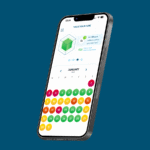The impact of health literacy on medication adherence
- Health literacy includes print, numeracy, and oral literacy skills, essential for understanding health information and making informed decisions.1
- Low health literacy is associated with poor health outcomes, increased hospitalization rates, higher healthcare costs, and medication errors due to inadequate comprehension.1,2
- Patients with limited health literacy struggle with medication instructions, leading to lower adherence, mismanagement of chronic conditions, and increased risks of complications.2
- Effective strategies include clear clinician-patient communication, simplified medication labels, visual aids, and structured disease management programs at both individual and system levels.3
What is health literacy?
Health literacy, a concept introduced in the 1970s, is a serious component of the cognitive and functional skills needed for adequate medication adherence and has become prominent factor in health outcomes. “The single biggest threat to health is the inability to understand it”, making health literacy essential for obtaining, processing, and comprehending essential health information needed to effectively manage their health and make informed decisions. This ability is crucial for effectively managing one’s health amidst the complexities of advancing healthcare systems.4 It encompasses various skills, such as:1
- Print literacy: Reading and understanding text, as well as locating and interpreting information in documents
- Numeracy: Using quantitative information for tasks like interpreting food labels, measuring blood glucose levels, and adhering to medication regimens
- Oral literacy: Speaking and listening effectively
Surveys conducted in industrialized nations—including the U.S., Canada, Australia, and countries within the European Union—have reported varying levels of health literacy prevalence: 46% in the U.S., 60% in Canada, 59% in Australia, and between 29% to 62% across the European Union5–8
In United States, interest in health literacy was sparked by unexpected results of the 1992 National Adult Literacy Survey (NALS). The survey revealed that approximately 40–44 million American adults were functionally illiterate, while approximately 50 million had marginally better functional literacy skills.9 Further, in 2003, the U.S. Department of Education conducted the National Assessment of Adult Literacy (NAAL), which, unlike the earlier NALS, included a specific component to evaluate health literacy with the intent to measure the ability to read, understand, and apply health-related information in English.10 The NAAL determined that 36% of US adults had basic or below-basic health literacy and identified significant differences in health literacy across sex, age, and race/ethnicity categories.10
Consequences of low health literacy
Low level of health literacy is directly linked to several adverse health outcome, including:
- Poor health outcomes and increased mortality risks due to inadequate understanding and management of their health conditions1
- Higher utilization of emergency services and increased hospitalization rates due to their inability to manage chronic conditions effectively and adhere to treatment plans2
- Lower use of preventive services such as vaccinations and screenings, which are crucial for maintaining good health and preventing complications1
- Increased likelihood of medication errors due to poor understanding of medication instructions11
- Higher healthcare costs resulting from inefficient use of healthcare resources12 and,
- Poorer self-care abilities13
A meta-analysis found a statistically significant positive correlation between health literacy and medication adherence (correlation coefficient range: 0.081 to 0.056; P < 0.001). Individuals with low health literacy may struggle to align with clinicians on prescribed medications. This can happen due to misalignment between patients and clinicians on prescription plan, patient choosing not to adhere to medication.14
About 42% of patients with low literacy cannot comprehend medication instructions, such as taking medications on an empty stomach, and may struggle to understand appointment slips or complex health documents.15 These individuals are less likely to be knowledgeable about their chronic diseases, have adequate self-management skills, or use preventive services effectively. Studies have shown that patients with limited health literacy were more likely to forget to take their medications and more likely to take less medication than instructed than patients with adequate health literacy.16 In patients with uncontrolled hypertension suggest low health literacy were significantly less likely to reconcile their chronic medications (18.0% vs 29.6%, P = 0.007); know their medication indications (64.1% vs 83.1%, P < 0.001); demonstrate understanding of instructions and dosing (68.1% vs 82.9%, P = 0.001).17 Many studies suggest that improving patients’ health literacy can be used as an effective education and prevention tool to improve disease management behaviors, including treatment adherence.18
Strategies for improving health literacy among patients
Enhancing health literacy can significantly improve medication adherence by ensuring patients understand their treatment plans and can manage their medications effectively. To bridge this gap, various interventions have been developed at different levels—individual, provider, system, and community levels—each targeting different aspects of health literacy.3,19,20
Clinician-patient level interventions:
One of the most effective interventions is improving clinician-patient communication. Studies suggest that patients with limited health literacy often struggle with medical jargon and complex information, making it crucial for healthcare providers to use plain language, slow down their speech, and limit key points to three or fewer per interaction. The teach-back method, where patients repeat or demonstrate what they have understood, has shown promising results in improving comprehension and adherence. Similarly, using visual aids, such as pictographs and simple infographics, can reinforce verbal instructions and significantly enhance understanding.
Table 1: Clinician-patient level interventions
| Intervention category | Strategies/actions |
| Patient-centered communication | – Assess what patients already know (“What do you already know about…?”) – Identify “What do I need to do?” rather than “What do I need to know?” |
| Clear health communication | – Use plain language (avoid medical jargon; use simple, straightforward sentences in verbal and written communications) – Communicate slowly – Attempt to match patient’s vocabulary – Keep number of points to ≤3 |
| Confirmation of understanding | – “What questions do you have?” – Teach back, teach-to-goal (does not increase visit duration) – Ask patients to say back or demonstrate what was just taught |
| Reinforcement | – Use multiple modalities (pictures, graphs, drawings); written information – Keep points to a minimum (short sentences ≤8 words) – Write legibly with large font – Use the active voice (eg, “Take your medicine at noon”) – 5th-grade level – Use patients’ support network/family |
| Numeracy and risk | – Use consistent denominator – Keep time span ∼10 years and consistent – Provide absolute risks, not relative risks – Avoid solely positive or negative framing |
| Medication reconciliation | – Fit dosing schedule around patient’s daily routine – Simplify regimens as much as possible – Use pillboxes, Medi-sets, and other medication organizers – Use visual medication schedules with computer programs or affixing pills to schedule – Make follow-up appointments to assess compliance and side effects – Include pharmacists if possible |
| Geriatrics | – Visual impairment (regular check-ups to monitor vision changes; visual aids: use 14-point non-Serif fonts (e.g., Arial, Helvetica), nonglossy materials with bright contrasting colors, and magnifying lenses; minimize glare with appropriate lighting – Hearing impairment (regular check-ups to assess hearing) |
System-patient level intervention
Health systems can enhance health literacy by simplifying communication, improving medication safety, and fostering patient engagement. Easy-to-read health materials, assessed using tools like Suitability Assessment of Materials (SAM) and the Lexile Framework, improve comprehension. Standardized medication labels with clear instructions and universal pictograms reduce errors. Disease management programs use tailored education, follow-up, and monitoring to support self-care, improve outcomes, and reduce hospitalizations—especially benefiting patients with low health literacy. Clinics should simplify signage, forms, and phone systems while promoting engagement through initiatives like “Ask Me 3.” These interventions empower patients, enhance self-care, and reduce hospitalizations, ultimately improving health outcomes for individuals with limited health literacy.
Table 2: System-patient level intervention
| Intervention category | Strategies/action |
| Health-education material | – Large font, text at 5th grade level, pictures, clear heading, and layout |
| Medication drug labels | – Use concrete instructions (“Take at 8 AM, 4 PM and midnight”) – Label should focus on the drug and the dosage – Use universal pictures that match the text – Drug label, pill bottle, and health education should be designed together and match |
| Disease self-management support | – Proactive, used to prevent poor outcomes before they happen – Disease-specific health literacy (eg, functional HIV health literacy like recognition of HIV terms) – Tailored to literacy and patient-perceived barriers – Multidisciplinary disease management education followed by telephone call back – Automated telephone calls |
| Creating an empowering environment | – Make the signs clear – Make the forms easy to read – Make the telephone triage system easy to navigate – Teach patients to ask: 1. What is my main problem 2. What do I need to do about the problem 3. Why is it important for me to do this? |
| Clinician training | – Continuing medical education credits – Clear health education while clinicians are in training – Requirements for board examinations |
Community-patient level intervention
Community-based interventions can help reduce health literacy disparities by promoting education, support, and accessibility. Referrals to adult literacy programs, often available at public libraries, not only improve literacy levels but also provide peer support and boost patient confidence in healthcare interactions. Lay health educators and navigators, trusted community members, bridge gaps in culture, language, and literacy, effectively enhancing knowledge, behavior change, and health outcomes while reducing costs. Additionally, mass media coverage of health information serves as a valuable tool for reaching diverse populations, making it an effective strategy for public health education and awareness campaigns.
Table 3: Community-patient level intervention
| Intervention category | Strategies/action |
| Education and programs | – Referrals to adult literacy classes – Use of lay health educators/navigators |
Conclusion and future direction
Health literacy is a pivotal determinant of patient outcomes, particularly in the management of chronic conditions such as hypertension, diabetes etc. Patients with limited health literacy often experience challenges in medication adherence, reconciliation, and self-management, leading to worsened disease control and increased healthcare utilization. Low health literacy is linked to poor health outcomes, the mechanisms driving these associations remain multifaceted, encompassing clinician-patient communication gaps, and inadequate patient engagement. Interventions at multiple levels—including clinician-patient, system-patient, and community-based approaches—have been identified as essential strategies for improving health literacy and its associated outcomes. Evidence suggests that patient-centered communication, simplified medication labeling, tailored self-management programs, and community-driven initiatives can significantly enhance adherence and reduce health disparities.
Future directions
To bridge the health literacy gap and improve patient outcomes, a multi-faceted approach is important. Future efforts should focus on tailoring interventions, integrating digital tools effectively, and embedding health literacy strategies into healthcare systems and policies.21 Key areas for advancement include:
- Personalized interventions: Tailor strategies based on cognitive, linguistic, and cultural factors; use teach-back methods and visual aids22,23
- Digital health literacy: Ensure accessibility of digital health tools for low-literacy populations to prevent disparities24
- Health system integration: Implement universal literacy precautions, standardized medication reconciliation, and simplified communication25
- Multidisciplinary collaboration: Engage clinicians, behavioral scientists, and policymakers to develop accessible health materials22,26
- Equity-focused strategies: Address health literacy disparities by considering social determinants of health27
- Evidence-based research and policy: Conduct randomized trials to assess long-term health literacy interventions and integrate findings into national healthcare strategies26
For more details on social determinants of health, please read our article: Rx for change: Addressing social determinants to improve medication adherence
“The greatest medicine of all is teaching people how not to need it.” — Hippocrates













